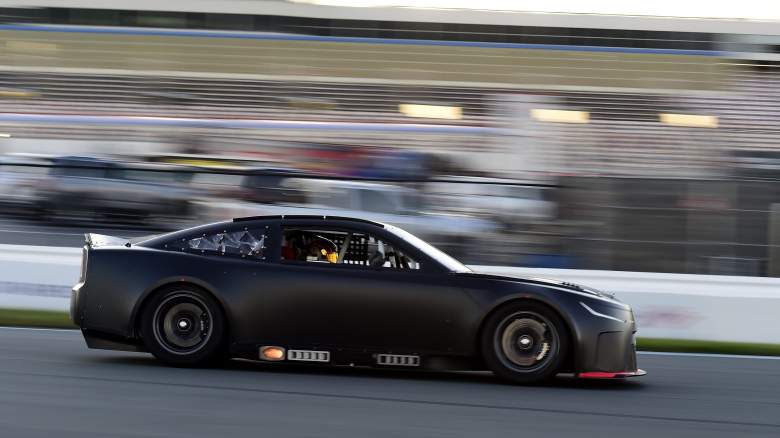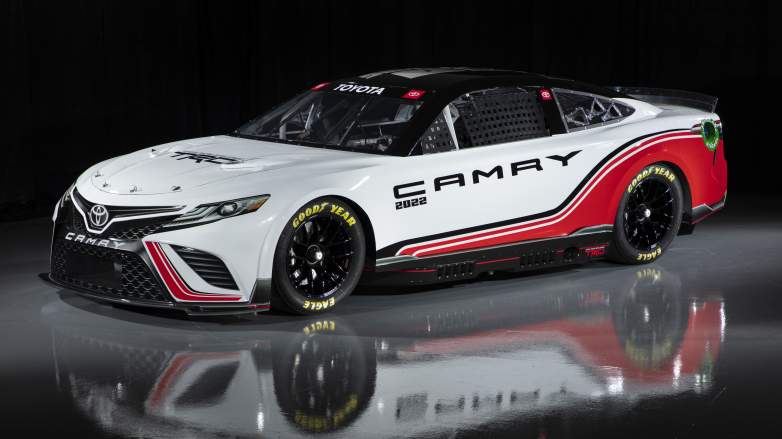
Getty NASCAR Next Gen test
The future is here for NASCAR‘s top manufacturers. Wednesday afternoon, racing’s sanctioning body held a special live stream ceremony to reveal the Next Gen race cars. Fans and drivers alike saw for the first time the new Toyota Camry, Chevrolet Camaro, and Ford Mustang that will debut starting in 2022.
The new designs look less like race cars and more like stock cars. NASCAR President Steve Phelps explained during the live presentation that the goal was to put the “stock” back in “stock car racing.” He believes that NASCAR achieved this goal after working with manufacturers, engineers, and drivers.
While the new cars debuted on Wednesday, the work is not yet done. NASCAR confirmed that Ryan Blaney is down at Texas Motor Speedway running more tests with the Next Gen car, and he is providing considerable feedback. Additionally, an IMSA champion got time behind the wheel to help improve the car before it debuts in the 2022 season. All in, the Next Gen has driven roughly 5,000 miles so far.
The new bodies will help the drivers keep racing after collisions

GettyNext Gen Chevrolet Camaro
NASCAR explained during the live stream that the new body will help the drivers stay on the track after incidents. They acknowledged that the current setup makes it very easy to cut a tire after bumping into another car. Now, however, the body should help the drivers hit the wall or each other without immediately having to go to the pits for repairs.
Of course, there will still be a steep learning curve for the Cup Series drivers. Both Joey Logano and Chase Elliott explained during the press conference that they will have a challenge each week as they try to reach Victory Lane. Information provided to the press confirmed that the new bodies “will reduce aerodynamic forces and put an emphasis back on race car setup and driver control.”

GettyNext Gen Toyota Camry
With the Next Gen car surfacing, there were questions about Toyota’s new race car. Many fans wanted to know why the Camry is the Cup Series car moving into the future instead of the Toyota Supra. David Wilson, President of TRD, explained that he is very happy with the Tundra in the Truck Series, the Supra in the Xfinity Series, and the Camry in the Cup Series. There are separate race cars for each series, all of which are unique in their own right.
The Next Gen Cars will feature multiple updates to improve costs

GettyThe Next Gen Ford Mustang
One of the major changes to the Next Gen car is that it will use a “standardized platform” to benefit the teams. According to AutoWeek, this means that a single source will build the chassis, supply parts, and supply a carbon composite body. Though the OEMs — Toyota, Chevrolet, and Ford — will all have distinct shells that resemble their respective streetcars.
Additionally, the new cars will feature larger, 18-inch wheels with a single lugnut as opposed to the 15-inch setup from the current generation. The transmission will incorporate a sequential shifter similar to rally cars instead of the traditional “H-shape” that Cup drivers currently use. Other upgraded specs that match the street versions of the race cars are independent rear suspension, rack and pinion steering, and larger brakes.
NASCAR President Steve Phelps previously explained that one major reason for updating the setup is to potentially bring in new OEM’s. Dodge used to field multiple cars in the Cup Series, but there are currently only three manufacturers that compete in 2020.
“I believe new OEMs and the relevance of this sport, where this sport now ranks within the sports entertainment landscape, is different than it was a year ago, two years ago, three years ago,” Phelps said in the months leading up to the unveiling. “With that, as well as the Next Gen car coming out next year, I think there’s going to be some renewed interest from an OEM perspective.”
Phelps also explained during the unveiling that NASCAR is focusing on all of its teams with the new vehicles. Smaller charters such as Trackhouse Racing and Live Fast Motorsports will benefit from the reduced costs, as will any new potential owners that want to get involved in the stock car racing.
READ NEXT: NASCAR’s Next Gen Car Hits the Virtual Track on Wednesday
Comments
NASCAR Unveils Next Gen Race Cars [LOOK]